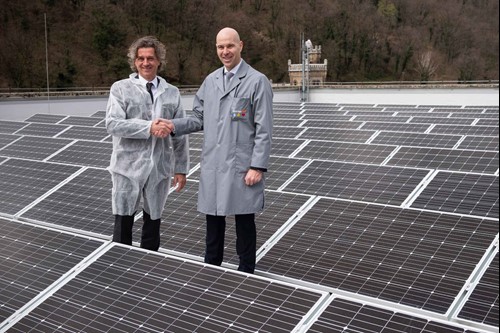Energy company Gen-I has partnered with technology company Razvojni center Novi materiali (RCeNEM) and glass manufacturer Steklarna Hrastnik for a new use case of green hydrogen in the industrial sector.
Gen-I has set up a solar PV system atop a glass factory in Slovenia. The array’s electricity will be used to generate hydrogen from an electrolyzer. The green hydrogen is then added to natural gas, which is used to fire the furnaces at the factory.
The setting-up of the solar power plant is part of the OPERH2 project, which is being co-financed by the Republic of Slovenia and the European Union, under the European Regional Development Fund (ERDF).
“With the help of innovative solutions and the latest technology, we have already reduced CO2 emissions by 30% in the glass tableware unit and by 10% in the glass packaging unit,” said Peter Čas, general director of Steklarna Hrastnik.
The development of the technology is currently in the pilot phase and RCeNeM is setting up the hydrogen production plant. “At the facility in question, we will produce extremely pure hydrogen through electrolysis and the use of energy from the solar power plant. That hydrogen will then be used in a pilot glass furnace with the aim of reducing the carbon footprint. We are thus introducing the use of a biocomponent in the fuel used in glass smelting,” said Tilen Sever, a researcher at RCeNeM, about the joint project with Steklarna Hrastnik.
In July this year, the PV array is expected to be connected to the electrolyzer. After the installation, the companies will continue to cooperate in order to analyze how the system performed. In the later stages of the project, the technology can be upscaled to more and bigger furnaces.
Popular content
Gen-I began the development of the technology last year with its partners. The aim was to find a way to reduce the use of natural gas, thus bringing down the carbon emission of the glass melting process. “The set-up of the solar power plant is an important step in the implementation of that technology,” emphasized the glass manufacturer's director.
A few weeks ago, scientists from Japan’s National Institute for Materials Science, the University of Tokyo and Hiroshima University conducted analysis to assess how storage may help further reduce the costs of solar-driven hydrogen production.
The scientists said rechargeable batteries, particularly those that can discharge only at a low rate, have the potential to reduce the costs of hydrogen production from solar to ¥17-27/m3 ($0.15-0.25). That, however, may only be possible in around 2030, when that type of battery is expected to have become economically viable, the research team added.
Another report by the European Climate Fund suggested that smart electrification could be 36% cheaper than large-scale use of green hydrogen. Though the authors of the report did concede that there are particular strong use cases for green hydrogen, such as industrial process heat or seasonal storage.
This content is protected by copyright and may not be reused. If you want to cooperate with us and would like to reuse some of our content, please contact: editors@pv-magazine.com.



By submitting this form you agree to pv magazine using your data for the purposes of publishing your comment.
Your personal data will only be disclosed or otherwise transmitted to third parties for the purposes of spam filtering or if this is necessary for technical maintenance of the website. Any other transfer to third parties will not take place unless this is justified on the basis of applicable data protection regulations or if pv magazine is legally obliged to do so.
You may revoke this consent at any time with effect for the future, in which case your personal data will be deleted immediately. Otherwise, your data will be deleted if pv magazine has processed your request or the purpose of data storage is fulfilled.
Further information on data privacy can be found in our Data Protection Policy.